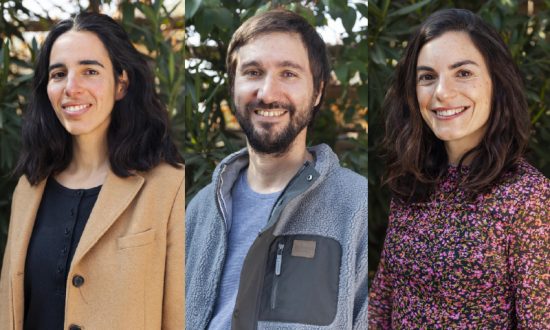Climb bars and watch the classrooms and their friends from the heights, smell the flowers, see the bees that the lavenders attract to the garden and observe the different colors and textures of ginkgos, quercus and pepper’s leaves, among other 15 plant and tree species. Play with their hands on mulch and soil and run up and down the brick hills. All this happens in a common recess at the Chilean Eagles College, at La Pintana, a vulnerable context neighborhood in Santiago, Chile. In children’s minds, they imagine that at the school ground they play with snakes and lions, says Karina Ravanal, the School Principal, boosting the game and the experience to the next level.
But it was not always like this. Two years ago, before the chilean nonprofit foundation Patio Vivo, (recognized as one of the seven innovative initiatives for Early Childhood in Latin America and the Caribbean by Unicef), transformed this school ground into a Learning Landscape, the space was made up of a big and empty concrete esplanade, with no shadow, no trees or not even places to sit and rest. According to the school’s educators, this used to be a very hostile playground that encouraged violent games, where fights and accidents were present every recess. This school ground, which is inhabited by 350 students from kindergarten to 2° grade, used to be very chaotic and noisy, while some of them played ball and ran everywhere, others sought refuge in the corners.
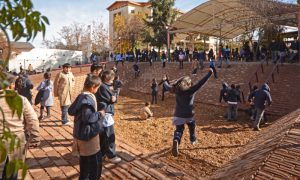
Unfortunately, this is the reality of many school grounds in urban areas, especially in schools of vulnerable contexts. Meanwhile the CNDU (National Urban Development Council) recommends 10 m2 of green area per inhabitant, barely 5,7% of Santiago’s population has access to this standard, which shows a strong deficit of access to natural spaces (Centro de Políticas Públicas UC, 2019). More and more girls and boys grow up in urban contexts, with few or no opportunities to play outdoors. On the other hand, 54,1% of chilean students presents overweight or obesity, according to Junaeb (National School Aid and Scholarship Board), an alarming reality, where at pre-K, kindergarten, and first grade, almost 3 out of 10 children are obese. And in terms of bullying and school violence, according to the IX National Youth Survey, carried out by the National Youth Institute (Injuv) and published in march 2021, 1 out of 4 students had suffered a physical or psychological violent episode at their schools .
In this context of adversity, at Patio Vivo we have seen that by transforming these hostile and hard schoolyards into Learning Landscapes, we are being a significant contribution to innovate in education and to increase the physical and socio-emotional well-being of students. And what is a Learning Landscape? This concept refers to a transformed schoolyard into a space that welcomes everyday children outdoors, in contact with nature, where free and risky play is promoted by diverse polyfunctional structures and where students can learn on the outside, and not only inside four walled classrooms. We see the schoolyard as the “third educator”, a concept developed by the italian pedagogue Loris Malaguzzi, who postulated that in addition to teachers and peers, the school ground is also an important tool of multiple actions and learning.
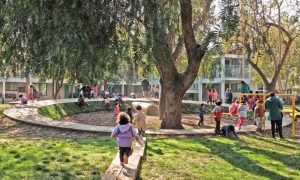
Since 2014 we have built more than 80 Learning Landscapes around 7 different regions in Chile, benefiting more than 32.000 students. None of these Learning Landscapes is equal to another. For us in Patio Vivo it is tremendously important to design each schoolyard according to each school context, their own culture and vision and the territory they inhabited. To achieve this articulation, we have developed an interdisciplinary method through a dialogue between Architecture and Education, which bonds the community with the transformed space and encourages them to reflect on the benefits of play.
Play revolution
Kindergartens and school grounds are for many kids the main place of play, as they have no other space where they can go every day to interact and share with their peers. Especially for those who grow up in urban contexts, with few or no opportunities to play outdoors on a daily basis, because of the lack of public spaces, the increasing sensation of insecurity and the new parenting habits that families are adopting, which are more sedentary and center in screens and technology. In addition, the Covid-19 pandemic exacerbated this situation due to lockdowns and virtual school lessons.
In that sense, school grounds have a great opportunity to contribute as a space that promotes free, active, risky and natural play. Children communicate with each other by playing, this is their language and their main tool for learning, and it plays a key role for healthy development. As the psychologist and researcher Peter Gray says, the considerable decline of active outdoor play in the last 60 years, is creating difficulties in developing socio-emotional skills, such as self-regulation, conflict resolution and empathy.
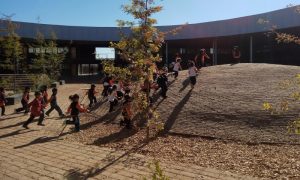
Free play allows children to discover their own interests, make decisions and explore the environment. By playing freely, without an adult direction or instruction, kids learn to relate and make friends. Also they learn other skills, such as organize themselves, collaborate and resolve conflicts. This activity in early childhood is closely linked to symbolic play, where imagination, creativity and autonomy are developed.
For its part, active play involves movement and coordination. Every time children jump, hang from a rope or crouch through a tunnel, they activate their vestibular and proprioceptive systems. The first one is related to the sense of movement of the body in space, it is linked to orientation, security, posture , balance, stable visual field, coordination of movements and alertness. While the second one, allows control of the position and movement of the body, so that children can plan and execute movements without problem and in a coordinated way. Active play allows to develop the will, healthy bodies and awake minds, besides it contributes to reverse the high figures of overweight and obesity that affect our country.
Risky play challenges kids, for which they learn to face their fears, be brave and understand risk, allowing them to be able to evaluate what things they can do and how. We build different polyfunctional structures in the school grounds that invite kids to climb, run, jump, or play as whatever they want. For example, in the game of bars, children need to self-regulate, as they must coordinate with their peers. Play with beneficial risk is promoted through spaces that stimulate the challenge according to the ages of the children.
It is also very important to understand that since these spaces do not exist, children will seek risk elsewhere. Like for example the students from the Chilean Eagles College, that before Patio Vivo, used to climb walls and fences around the school, spaces that are not designed for this and therefore they can be very dangerous and a source of accidents.
At last, when playing in contact with nature, students receive lots of stimulation and a diversity of experiences. Boys and girls can play with all their senses, exploring and observing organic materials, which change according to the season of the year. Thus, they learn to observe, know the rhythms of nature, develop their attention watching how trees change through months, and it allows them to feel part of nature and the ecosystem.
In Patio Vivo, we believe in a play revolution. Our call is to look at recess and play, not only as a moment for leisure and rest, but as a relevant moment of the day, where learning is more active than ever. A recess where students enjoy themselves, release energy through movement, dialogue and develop various socio-emotional skills, allows them to return to the classroom with a much more positive attitude and willingness to learn, which improves school performance and reinforces the feeling of belonging.
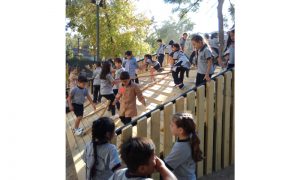
We are all nature
Another fundamental pillar for Patio Vivo is the bond between children and nature. When designing a new Learning Landscape, the choice of materials aims to promote play in its four different types, and enhance the value of the school’s territory and culture, as we mentioned before. We use noble, long-lasting organic materials that allow students to experience different textures and smells. While playing around trees and soil, or on structures purposely designed for free play, students learn about materials, culture, nature’s cycles and the region’s native flora.
What message about the territory are we transmitting to children and adolescents in schools? How are we involving them in caring for the Earth? A Learning Landscape full of life, where colors such as green and brown predominate and where there is space also for other living beings, express to students nature care, as they also relate with other species and recognize themselves as part of nature. In the face of the climate emergency that the world is experiencing, it is of the utmost importance to contribute to adding new agents of change and care for the environment. One of our dreams is that each school and kindergarten transform their school grounds from an arid desert to a fertile place, so that we can begin to generate a network of living gardens that will form an ecological corridor for the city’s biodiversity.
As in the Learning Landscapes, this can be done by planting trees and plants and removing cement and replacing it with drainage pavements, such as soil, mulch or bricks, where the water drains towards the earth and maintains its humidity. In this way we do not waste the rainwater that normally runs towards the urban collectors, drying the groundwater.
The 21st century requires polyfunctional educational spaces that provide opportunities for hands-on learning and foster the physical, socioemotional and cognitive development of students. As Patio Vivo, we make an invitation to the teaching teams, to look at educational spaces from another perspective and observe how these changes lead to a better energy, school motivation and sense of belonging. Let’s keep transforming the schools, so we can see every day more active kids that enjoy playing freely and learning outside. Children that have a special place to develop multiple skills, such as creativity, critical thinking, problem resolution and communication abilities. And where education emerges from fertile land, where students can really feel part of nature. We are all nature!
Testimonials:
“In terms of impact on their psycho-emotional well-being, students themselves have reported that the new school ground is a privileged space for meeting with themselves and for tranquility. There is an immediate, concrete and significant contribution, in achieving certain states of mind that predispose them positively towards learning.” – Carlos Valderrma, IAPB School Principal
“We have students who go home saying ‘I can’t be absent again, they will miss me’. This is an important space for growth, opening and other possibilities, so that they can express their emotions and interact with others.” – Karina Ravanal, Chilean Eagles College School Principal
About Angela Ibanez
Ángela Ibáñez is co-founder and executive director of Patio Vivo Foundation, a non-profit organization aimed at giving children the opportunity to grow, play and learn in contact with nature, founded in Chile in 2014. Most of its projects are focused on greening school grounds to improve children’s well-being and regenerate ecosystems in vulnerable urban schools. Angela has been recognized within her 100 Women Leaders 2020 in her country.
About Martial Huneeus
Martial Huneeus is the Director of Education at Patio Vivo Foundation. He is in charge of promoting cultural change in educational communities, in order to transform the playground into a pedagogical tool. Marcial leads the work with educational communities and participation, promoting learning methodologies from experience and addressing topics such as the benefits of free, active play in contact with nature. Member of the Latin American School Coexistence Network. Bachelor of Arts and Master of Literature from the Catholic University of Chile. Trained in Waldorf pedagogy.
About Andrea Manuschevich
Andrea Manuschevich is the Communications Coordinator at Patio Vivo Foundation. Andrea works mainly in transmitting Patio Vivo’s work and connecting it with other relevant educational actors and partners. Journalist and graduate in Social Communication from the Catholic University of Chile and photographer graduated from the School of the International Center of Photography.




